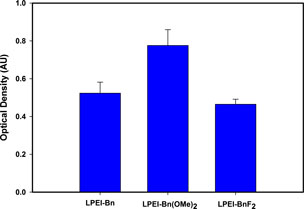Crossref Citations
This article has been cited by the following publications. This list is generated based on data provided by
Crossref.
Pelster, Lindsey N.
Meredith, Matthew T.
and
Minteer, Shelley D.
2012.
Nicotinamide Adenine Dinucleotide Oxidation Studies at Multiwalled Carbon Nanotube/Polymer Composite Modified Glassy Carbon Electrodes.
Electroanalysis,
Vol. 24,
Issue. 5,
p.
1011.
Meredith, Matthew T.
Giroud, Fabien
and
Minteer, Shelley D.
2012.
Azine/hydrogel/nanotube composite-modified electrodes for NADH catalysis and enzyme immobilization.
Electrochimica Acta,
Vol. 72,
Issue. ,
p.
207.
Moehlenbrock, Michael J.
Meredith, Matthew T.
and
Minteer, Shelley D.
2012.
Bioelectrocatalytic Oxidation of Glucose in CNT Impregnated Hydrogels: Advantages of Synthetic Enzymatic Metabolon Formation.
ACS Catalysis,
Vol. 2,
Issue. 1,
p.
17.
Wu, Fei
and
Minteer, Shelley D.
2013.
Fluorescence Characterization of Co-immobilization-Induced Multi-Enzyme Aggregation in a Polymer Matrix Using Förster Resonance Energy Transfer (FRET): Toward the Metabolon Biomimic.
Biomacromolecules,
Vol. 14,
Issue. 8,
p.
2739.
Hickey, David P.
Giroud, Fabien
Schmidtke, David W.
Glatzhofer, Daniel T.
and
Minteer, Shelley D.
2013.
Enzyme Cascade for Catalyzing Sucrose Oxidation in a Biofuel Cell.
ACS Catalysis,
Vol. 3,
Issue. 12,
p.
2729.
Walcarius, Alain
Minteer, Shelley D.
Wang, Joseph
Lin, Yuehe
and
Merkoçi, Arben
2013.
Nanomaterials for bio-functionalized electrodes: recent trends.
Journal of Materials Chemistry B,
Vol. 1,
Issue. 38,
p.
4878.
Reid, Russell C.
Giroud, Fabien
Minteer, Shelley D.
and
Gale, Bruce K.
2013.
Enzymatic Biofuel Cell with a Flow-through Toray Paper Bioanode for Improved Fuel Utilization.
Journal of The Electrochemical Society,
Vol. 160,
Issue. 9,
p.
H612.
Yu, Jiang
Rasmussen, Michelle
and
Minteer, Shelley D.
2013.
Effects of Carbon Nanotube Paper Properties on Enzymatic Bioanodes.
Electroanalysis,
Vol. 25,
Issue. 5,
p.
1130.
Shrier, Alexander
Giroud, Fabien
Rasmussen, Michelle
and
Minteer, Shelley D.
2014.
Operational Stability Assays for Bioelectrodes for Biofuel Cells: Effect of Immobilization Matrix on Laccase Biocathode Stability.
Journal of The Electrochemical Society,
Vol. 161,
Issue. 4,
p.
H244.
Reid, Russell C.
Minteer, Shelley D.
and
Gale, Bruce K.
2015.
Contact lens biofuel cell tested in a synthetic tear solution.
Biosensors and Bioelectronics,
Vol. 68,
Issue. ,
p.
142.
Aquino Neto, Sidney
Hickey, David P.
Milton, Ross D.
De Andrade, Adalgisa R.
and
Minteer, Shelley D.
2015.
High current density PQQ-dependent alcohol and aldehyde dehydrogenase bioanodes.
Biosensors and Bioelectronics,
Vol. 72,
Issue. ,
p.
247.
Quah, Timothy
Abdellaoui, Sofiene
Milton, Ross D.
Hickey, David P.
and
Minteer, Shelley D.
2017.
Cholesterol as a Promising Alternative Energy Source: Bioelectrocatalytic Oxidation Using NAD-Dependent Cholesterol Dehydrogenase in Human Serum.
Journal of The Electrochemical Society,
Vol. 164,
Issue. 3,
p.
H3024.
Yuan, Mengwei
Sahin, Selmihan
Cai, Rong
Abdellaoui, Sofiene
Hickey, David P.
Minteer, Shelley D.
and
Milton, Ross D.
2018.
Creating a Low‐Potential Redox Polymer for Efficient Electroenzymatic CO2 Reduction.
Angewandte Chemie International Edition,
Vol. 57,
Issue. 22,
p.
6582.
Aquino Neto, Sidney
Minteer, Shelley D.
and
de Andrade, Adalgisa R.
2018.
Developing ethanol bioanodes using a hydrophobically modified linear polyethylenimine hydrogel for immobilizing an enzyme cascade.
Journal of Electroanalytical Chemistry,
Vol. 812,
Issue. ,
p.
153.
Yuan, Mengwei
Sahin, Selmihan
Cai, Rong
Abdellaoui, Sofiene
Hickey, David P.
Minteer, Shelley D.
and
Milton, Ross D.
2018.
Creating a Low‐Potential Redox Polymer for Efficient Electroenzymatic CO2 Reduction.
Angewandte Chemie,
Vol. 130,
Issue. 22,
p.
6692.
Grattieri, Matteo
Hickey, David P.
Kim, Han Sol
Seijas, Vanesa Teijeiro
Kim, Jungbae
and
Minteer, Shelley D.
2018.
Lag Time Spectrophotometric Assay for Studying Transport Limitation in Immobilized Enzymes.
ACS Omega,
Vol. 3,
Issue. 9,
p.
11945.
Yuan, Mengwei
Kummer, Matthew J.
Milton, Ross D.
Quah, Timothy
and
Minteer, Shelley D.
2019.
Efficient NADH Regeneration by a Redox Polymer-Immobilized Enzymatic System.
ACS Catalysis,
Vol. 9,
Issue. 6,
p.
5486.
Bulutoglu, Beyza
Macazo, Florika C.
Bale, Jacob
King, Neil
Baker, David
Minteer, Shelley D.
and
Banta, Scott
2019.
Multimerization of an Alcohol Dehydrogenase by Fusion to a Designed Self-Assembling Protein Results in Enhanced Bioelectrocatalytic Operational Stability.
ACS Applied Materials & Interfaces,
Vol. 11,
Issue. 22,
p.
20022.





